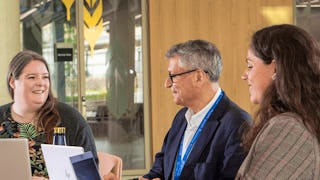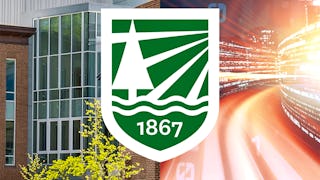How do firms lead successful digital transformations? The course answers the question. Developed by Professor Pankaj Setia at the Indian Institute of Management Ahmedabad (IIMA), the course teaches the professor’s well-renowned DaWoGoMo© model. To teach the model, Professor Setia explains many different examples of digital transformations, some involving advanced implementations of artificial intelligence. The course presents and highlights ways to successfully transform various aspects of organizations, to create a digital organization. For learners, the course imparts a way to think deeply and become familiar with various aspects that they may have to navigate, to successfully create, champion, or engage with a digital transformation. Real-life cases and scenarios enhance the learning experience

Enjoy unlimited growth with a year of Coursera Plus for $199 (regularly $399). Save now.

How to Transform Digitally?
This course is part of Advanced Digital Transformation Specialization

Instructor: Pankaj Setia
6,389 already enrolled
Included with
(38 reviews)
Recommended experience
What you'll learn
Prof Setia’s DaWoGoMo Model: Digital Architecture, Work, Governance, Business Models and Culture
Learn from organizational examples how advanced and cutting-edge operations are championed through digital technologies, such as AI technologies
Plan work transformation that architect advanced work system, such as those leveraging artificial intelligence-based technologies
Business Model Transformation: Appraise business models–such as those associated with digital platforms–and their ability to create value
Skills you'll gain
Details to know

Add to your LinkedIn profile
See how employees at top companies are mastering in-demand skills

Build your subject-matter expertise
- Learn new concepts from industry experts
- Gain a foundational understanding of a subject or tool
- Develop job-relevant skills with hands-on projects
- Earn a shareable career certificate

There are 6 modules in this course
This module introduces you to the operational purpose of digital transformation. Various examples are discussed to outline how organizations digitally transform themselves. While discussing how firms have transformed digitally, the module unravels concepts highlighted by scholars and thinkers, to digitally transform business operations. Some of the exemplars of notable digital transformation are discussed. In the module, Professor Setia introduces the DaWoGoMo model which forms the foundation for this course.
What's included
10 videos8 readings3 assignments
In this module, you will learn about the transformation of an organization’s digital architecture. The module underlines the need to view organizations as computational entities. Additionally, Professor Setia's lectures discuss the core concepts and relationships related to digital architectures that a firm needs to master. You will gain insight into how the principles apply to the domains of cybersecurity and cloud architecture. Professor Setia discusses the key managerial principles that one needs to think about to undertake a successful and meaningful transformation of digital architectures.
What's included
11 videos7 readings3 assignments
In this module, you will learn about how digital transformation entails the transformation of work. Transformation of work is an ongoing process. In this module, Professor Setia explains how the work has transformed before and how it is transforming today. There are complex dynamics associated with the advent of new technologies. Managers have to carefully assess the relationship and fit of technology with the ways of work. This module brings out these insights. Further, managers also have to think about what to transform. Professor Setia discusses the transformation of work constitution and rhythms, as two crucial dynamics that a manager has to master.
What's included
10 videos5 readings3 assignments1 discussion prompt
In this module, you will learn about transforming the governance of an organization. in the module, Professor Setia explains how the induction of digital technologies makes the governance transformation imperative. Managers have to reflect upon the ways to rethink governance. For example, automation requires defining the primary and secondary decision-makers. Organizations are faced with a trade-off in choosing different governance options. Professor Setia highlights the process of transforming governance during digital transformations by giving a transformation logic that helps understand and overcome the trade-off.
What's included
12 videos5 readings4 assignments
In this module, you will learn how different organizations transform their business models. You will also learn how to identify the strengths and weaknesses of different business models. Specifically, in the module, Professor Setia unravels the two criteria necessary for business model transformation. Stakeholders play a crucial role in digital transformation. You will learn about the divergence and equilibrium across stakeholders and their impacts on a business model's value. Additionally, you will also learn about platform and sharing models that are gaining greater significance. In the module, Professor Setia explains how to apply his DaWaGoMo model, for operationalizing a successful digital transformation. In doing so, you will become familiar with an extended DaWoGoMo model that helps overcome various challenges, such as resistance to digital transformation.
What's included
15 videos6 readings5 assignments
This Peer-Review Assignment aims to help you reflect upon the core concepts covered in the Advanced Digital Transformation (Part 2) course
What's included
1 peer review
Earn a career certificate
Add this credential to your LinkedIn profile, resume, or CV. Share it on social media and in your performance review.
Instructor

Offered by
Explore more from Leadership and Management
 Status: Free Trial
Status: Free TrialIIMA - IIM Ahmedabad
 Status: Free Trial
Status: Free TrialUniversity of Glasgow
 Status: Free Trial
Status: Free TrialUniversity of Virginia
 Status: Free Trial
Status: Free TrialDartmouth College
Why people choose Coursera for their career




Learner reviews
38 reviews
- 5 stars
81.57%
- 4 stars
13.15%
- 3 stars
2.63%
- 2 stars
0%
- 1 star
2.63%
Showing 3 of 38
Reviewed on May 12, 2024
Excellent course. Very good presentation from Professor. Easy to understand.
Reviewed on Feb 11, 2024
Very good course that drives thinking in both areas; theory and practical examples
Reviewed on Jul 29, 2025
The scientific approach, background with context and the detailed explanation by Professor Setia, makes this one of the greatest courses I have attended in my post graduate studies.
Frequently asked questions
To access the course materials, assignments and to earn a Certificate, you will need to purchase the Certificate experience when you enroll in a course. You can try a Free Trial instead, or apply for Financial Aid. The course may offer 'Full Course, No Certificate' instead. This option lets you see all course materials, submit required assessments, and get a final grade. This also means that you will not be able to purchase a Certificate experience.
When you enroll in the course, you get access to all of the courses in the Specialization, and you earn a certificate when you complete the work. Your electronic Certificate will be added to your Accomplishments page - from there, you can print your Certificate or add it to your LinkedIn profile.
Yes. In select learning programs, you can apply for financial aid or a scholarship if you can’t afford the enrollment fee. If fin aid or scholarship is available for your learning program selection, you’ll find a link to apply on the description page.
More questions
Financial aid available,
¹ Some assignments in this course are AI-graded. For these assignments, your data will be used in accordance with Coursera's Privacy Notice.





